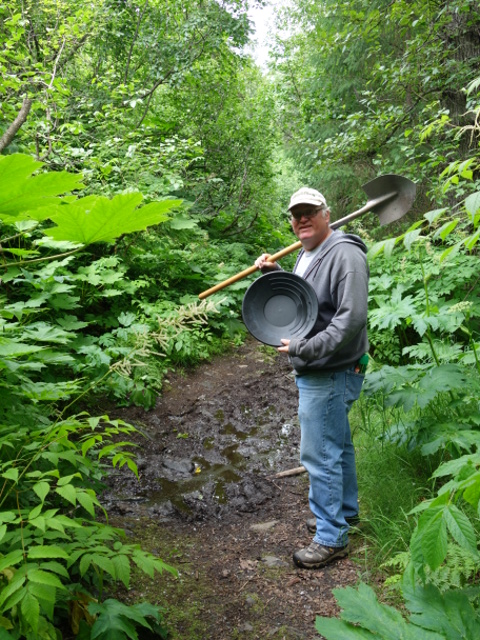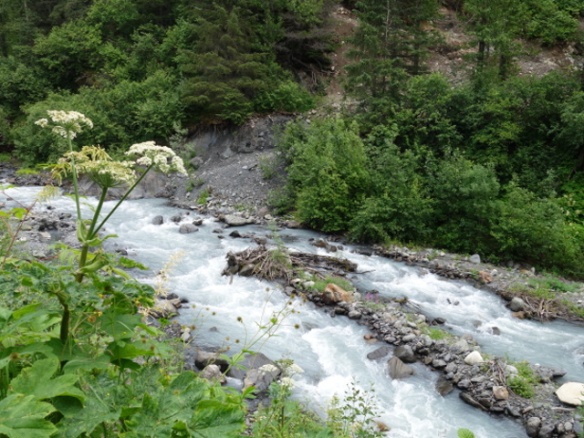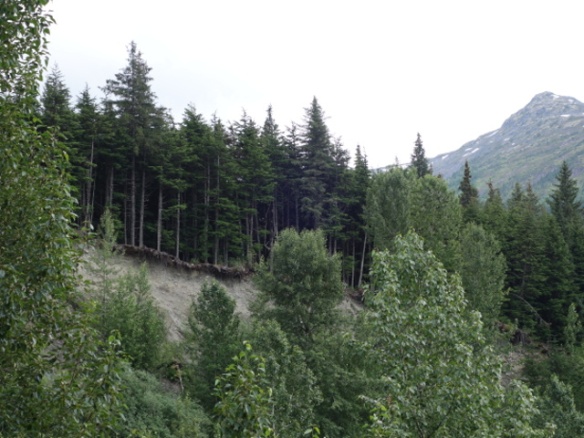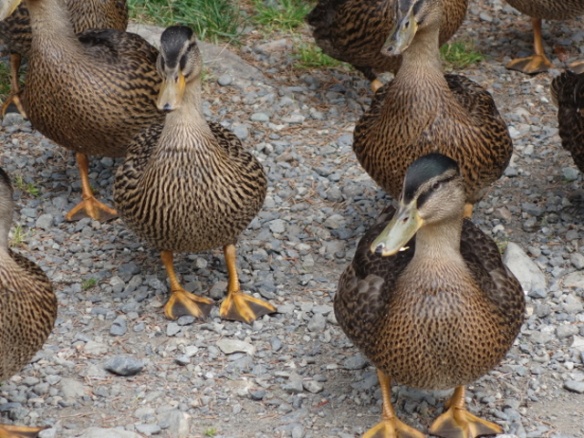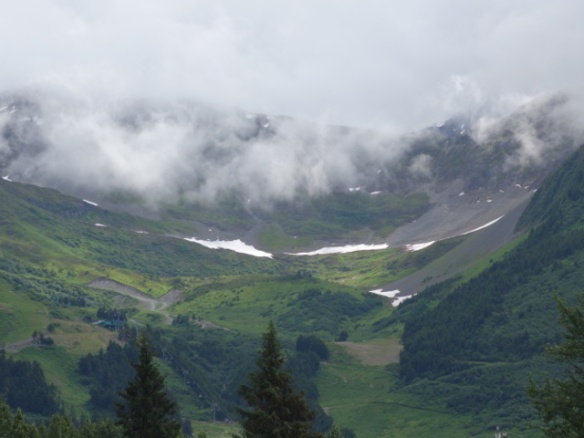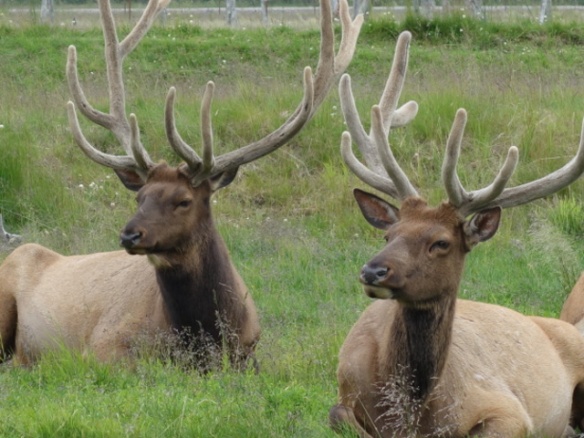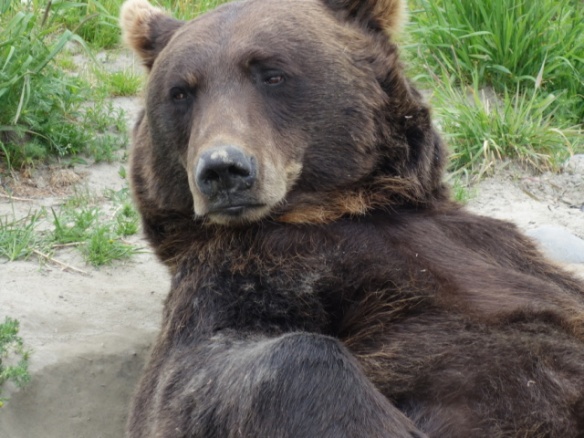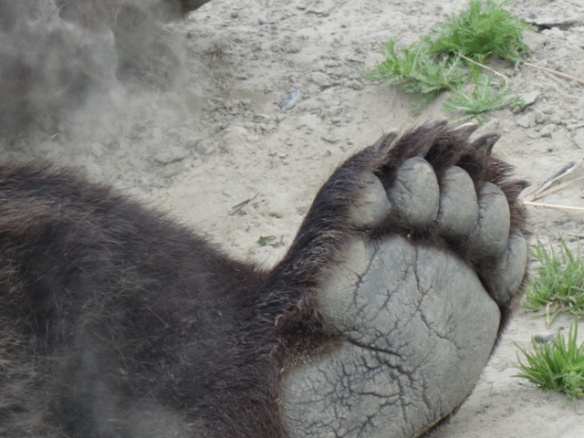Atlin is in beautiful British Colombia and referred to as the ‘Switzerland of the North’. Simply a stunning place and one that wasn’t on our hit list until our new friend Ramona sang its praises over dinner one evening while in Alaska. She said she’d move there if she could. Now that’s a ringing endorsement. After reworking the schedule yet again, we carved out three nights and would love to have stayed twice as long.
On The Way
Only one road goes to Atlin and that’s out of the Yukon. We were more than happy to make that 57 mile detour off the Alaska Highway and loved our lunch stop. So pretty that we pulled out our chairs and sat for a while on the shore of Little Atlin Lake. Peaceful and hardly anyone on that road at all. We could hear the ducks across the water, the buzzing of the insects and the lapping lake water.



We figured we’d better get Poop in on the act, too, since he hadn’t been photographed in the Yukon.

I woke him up and he’s busily talking and sneezing. And the Yukon was close to being his new home since we almost left him on that rock by accident.
Norseman Adventures RV Park
The campground in Atlin was a tad cozy shall we say, but you couldn’t beat the views. Totally worth it and the close proximity helped us to meet our neighbors Jakob & Maggie from Atlanta, and a cute young couple in a rental van on a 3-week holiday from the Netherlands.

The park had these fun Norseman signs pointing the way through town. Not that you could really get too lost. It’s a small place with only 400 residents. And as you can tell from the sign, they are pretty proud of the internet they provide. That is so important in this town since there is absolutely no cell service of any kind. Don’t care what kind of phone or plan you have. No cell tower means no cell service. Of course the internet had some strings. Only available from 10-noon and 4-6pm, (costs were through the roof you know) AND…

…you have to stand really close to this little outhouse-like building. If another RV was between you and it, no go. The pay phone does work. When was the last time you saw one of those?
Now you’re wondering why this place is so great if communication is such an issue and the spaces are so close. The view.

Our spot right on Atlin Lake.


And the views out our front window.
Of course I cheated and took these outside the RV, but I have a very good reason…

This would have been a super shot of the little island in our beautiful view, but my very smart camera focused in on the bug splats instead of what I wanted. I can’t tell you how many really swell shots you missed from this trip since I only ended up with windshield gunk and bug guts.
But I digress. Even if this hadn’t been a drop-dead gorgeous spot, we had plenty of entertainment compliments of Atlin Air. The pilot would fly in and out all day long taking supplies, picking up people, and flying sightseeing tours of the area.
We were able to watch take-offs and landings multiple times a day. Seems like every time he went somewhere, all the campers stopped what they were doing to watch in rapt attention. Also, the pilot is Swiss as were a few other campers, and our new friend Jakob. Apparently this is a favorite vacation spot for Swiss visitors adding a little authenticity to that ‘Switzerland of the the North’ moniker.
Atlin Mountain

Atlin Mountain takes center stage in the view from town. This mountain isn’t the tallest at 6,712 feet, or the most interesting in shape, but it is unique. That slide looking area in the middle is actually a rock glacier. The Atlin Claim Special Visitor’s Edition describes it this way: “Although not a real glacier, it behaves as a real glacier does; flowing, deforming and advancing into the forest areas at its toe.” I’d never heard of such geology and it is something to see. And that visitor’s edition paper we were given when we arrived? From 2007! It’s a little like going back in time here.
The mountain also sits on Atlin Lake, the largest natural one in BC.

We drove to a ridge just outside of town on another gravel road, and tramped to the microwave tower to get this view of the town and Atlin Lake. That island isn’t as little as it looks from our RV window. We’e decided that if we have lakefront like this, maybe we don’t need a riverwalk when we finally settle somehwhere. Of course a lot of the appeal here is being off the beaten path with no highways and no crowds.
The Town
Atlin had all we needed. A place to park Lucy, a laundromat, art gallery/gift shop, and the Pine Tree Restaurant. I did some laundry and browsed the gift shop while I waited. Dinner at the Pine Tree was a special treat. The owners were having their “grand opening” since buying it from the previous owner. Turns out they were giving away prizes to lucky diners as part of the celebration.
I won a huge gift basket, proudly presented by the owner over dinner. They took my picture for their bulletin board, and the chef even came out to see who won since he randomly picks the winning “plate”. Of course I wasn’t the only winner. Vonnie won a cupcake tower and shared with all the rest of us. Her story is so interesting. She and her partner Jim have a gold claim just outside of town and are really working it. He’s a geologist and figures out the best locations to dig. Her gold mining career started after she came out on vacation to cook temporarily for the miners while visiting Jim. And just like that she was hooked. No administrative job in the city for her any longer.

Atlin also boasts one of the old boats similar to the sternwheeler we saw in Whitehorse. The Tarahne was a cargo and passenger boat before Atlin had road access. After the road connection in 1949 it was put out to pasture. On the hill in the background, you can see the tower where we took the town overlook photo.
Out and About
We had to get Jackson in on the act, so we took a drive to the “beach” just outside of town.
Nothing like some good off-leash stick fetching.
We also read that the road to Surprise Lake would be closed for a few days so figured we’d better head there to see it. Another adventure down a longer gravel road.

Surprise!
More stick fetching to be done. But off leash dog tried to sneak off. Good thing he tires easily these days and doesn’t want to be left behind. I start up the car and pretend to drive and he comes running.

We did a little exploring without Jackson and went to Warm Bay. Another gravel road adventure. It was so quiet you could hear the trees creaking in the wind.
I was determined to find The Grotto at the end of the road. We got to the sign that said the road was no longer maintained, which I’m guessing means an even rougher gravel road. Since I hadn’t found anything that looked remotely like a grotto, we went just a tad further and finally found it. This stream comes out of a rocky outcropping that does indeed look like a grotto. Lots of little waterfalls and damp, mossy logs were up in this secluded area.
Monarch Mountain
Our real goal on the last day in town was to hike to the top of Monarch Mountain for the promised spectacular views of the area.

We got a late start after the Grotto hunt and I blame that for our shortened hike.


We didn’t make it all the way up since it was a pretty warm day and quite steep, but we still saw some gorgeous views. I’m posing with Birch Mountain in the background. It sits on Teresa Island, the second tallest lake island on the planet. Just around the bend to the left is the Llewellyn Glacier and to the right is the Williston glacier. Pat, on the other hand, has Atlin Mountain behind him.

This is my favorite shot from our vantage point on Monarch Mountain. You can just make out the tiny town on the shore to the right of that lone tree. The Atlin Air pilot flew off in the direction of those far mountains while were up there hiking.

A little closer view of Birch Mountain on Teresa Island.
Campground Parting Shots
On the lake shore by our campsite, there was this interesting bush. I think it had flowers on it at one point, but no longer.

Now it just looks like a bunch of Barbie doll heads. You see it, too, right? Just makes me want to get out that little pink comb and brush that hair.
We were also treated to a show by Eddie the eagle and our campground host, Norman, every evening.

Eddie would sit on the light pole behind the campsites and wait for Norman to produce a fish for him to eat. He’d swoop down and get it and then he and Mrs. Eddie (as Norman called her) would head back to the nest to feed up the eaglets.
I mentioned that the campsites were cozy. Well we didn’t have space for Bitsy so we parked her by the road. On the last night it was under Eddie’s light pole. I got in to drive behind Pat before we connected on bugout morning, and just burst out laughing

This is what it looks like when you park under the eagle perch for the evening. I didn’t wash the windshield until Pat could get the full view. It was so bad that we could see all the splats on top of the car from Lucy’s rear camera. Yes, we remain dirty top to bottom at this point.

I’ll leave you with a shot of the calm lake water and those colorful rocks on the bottom. Pat keeps calling me Lucy (from the Long, Long Trailer) since I keep stuffing them in my pockets when he isn’t looking. If we are overweight one day, it’ll be because of my rock collection.
Next up is a little more Yukon, some BC and yes, our detour to the Northwest Territories. See you on the way!































































































































































